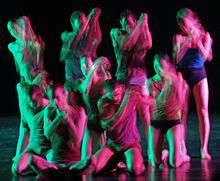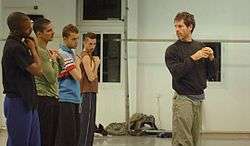Ohad Naharin
Ohad Naharin (born 1952) (Hebrew: אוהד נהרין) is an Israeli contemporary dancer and choreographer. He served as artistic director of Batsheva Dance Company from 1990; he stepped down in 2018.
Ohad Naharin | |
|---|---|
אוהד נהרין | |
.jpg) | |
| Born | 1952 |
| Citizenship | Israeli and american |
| Occupation | Contemporary dancer, choreographer and dance company artistic director to 2018 |
| Employer | Batsheva Dance Company |
| Style | Contemporary dance |
| Title | House choreographer |
| Spouse(s) | Mari Kajiwara (1978 ~ 2001) Eri Nakamura (~ present) |
| Children | 1 daughter (with Eri Nakamura) |
| Awards |
2010 dance magazine award 2013 honorary doctor Juilliard school |
Biography
Ohad Naharin was born in 1952 in Kibbutz Mizra.[1] Raised in an artistic home, he wrote stories, composed music, and painted as a child. His father was a psychologist specializing in psychodrama and an actor who performed with Habima and the Haifa Theater. His mother was a Feldenkrais instructor, choreographer and dancer. [2] Nevertheless, Naharin did not start dancing until age 22.[3] During his first year with the Batsheva Dance Company, Martha Graham visited Israel and invited Naharin to join her dance company in New York. After dancing for Martha Graham, he attended Juilliard and the School of American Ballet.[4]
In 1978, he married Mari Kajiwara, a native New Yorker and an Alvin Ailey dancer. In 2001, she died of cancer at age 50.[5]
He is now married to Eri Nakamura, a Batsheva dancer and costume designer with whom he has a daughter.[6][7]
Batsheva Dance Company

Naharin is currently the House Choreographer of Batsheva Dance Company.[8] He served as Artistic Director as well until 2018.[8] In 1990, Naharin was appointed Artistic Director,[9] there by launching the company into a new stage. The company is international in nature, made up of individually unique dancers from Israel and other countries. Dancers are encouraged to affirm their distinct creative gifts, as creators on their own.[10]
Naharin's signature style and technique has developed during his time with Batsheva. His style is "distinguished by stunningly flexible limbs and spines, deeply grounded movement, explosive bursts and a vitality that grabs a viewer by the collar."[5] His dancers do not rehearse in front of a mirror as this enables them to move away from self-critique and allows them to feel the movement from within. Naharin is known to be a reserved and private person, and this is apparent in the studio as well. He does not get angry or raise his voice, but comments constructively and calmly.[5] Since he has also been musically trained, Naharin sometimes collaborates on the compositions used in his pieces.[11]
Gaga
During his time directing and teaching the Batsheva Company, Naharin developed Gaga, a movement language and pedagogy that has defined the company's training and continues to characterize Israeli contemporary dance.[12] A practice that resists codification and emphasizes the practitioner's somatic experience, Gaga presents itself as a movement language rather than a movement 'technique'. Classes consist of a teacher leading dancers through an improvisational practice based on a series of images described by the teacher.[13] Naharin explains that such a practice is meant to provide a framework or a "safety net" for the dancers to use to "move beyond familiar limits".[14] The descriptions that are used to guide the dancers through the improvisation are intended to help the dancer initiate and express movement in unique ways from parts of the body that tend to be ignored in other dance settings. One example is the image of "Luna", which refers to the fleshy, moon-shaped regions between fingers and toes.[15] In keeping with Gaga's insistence on moving through sensing and imagining, mirrors are discouraged in rehearsal spaces.[13]
Choreography
Naharin's works have been commissioned by the Frankfurt Ballet, Opéra National de Paris, Grand Théâtre de Genève, Sydney Dance Company, Lyon Opera Ballet, Les Grands Ballets Canadiens, Rambert Dance Company, Compañia Nacional de Danza, Cullberg Ballet, Finnish National Ballet, Ballet Gulbenkian, Balé da Cidade de São Paulo, Bavarian State Ballet, Cedar Lake Contemporary Ballet, Pittsburgh Ballet Theatre, Hubbard Street Dance Chicago and Royal Danish Ballet.
He seeks to create movement that is universal yet personal. He always has a clear social and political conscience in his works, but his dances are not meant to be political. He finds storytelling of suffering and the world's problems boring in comparison to a person's ability to use texture and multi-layered movement. He contrasts physical explosiveness with stillness, taking an interest in contrasts, edges, and extremes, which creates vital distance and space in dances. His philosophy, shared with many who devote their lives to choreography, is that everyone should dance.[16] Deca Dance highlights many excerpts from his previous works. Naharin says himself, "Deca Dance is not a new work. It is more about reconstruction: I like to take pieces or sections of existing works and rework it, reorganize it and create the possibility to look at it from a new angle. It always teaches me something new about my work and composition. In Deca Dance I took sections from different works. It was like I was telling only either the beginning, middle or ending of many stories but when I organized it the result become as coherent as the original if not more."[10]
In Max, "Mr. Naharin’s theatrical ingredients are space, movement and light."[17] A critic comments, "In this tremendously potent work, there are few obvious displays of emotion, yet Max is full of imagery that slips between real life and dance in fleeting flashes."[17]
Anaphase, a work for 22 dancers and two musicians, combines elements of theater, opera, film and rock music as well as dance. According to Naharin, it "deals with small sculptures in a big space" and explores the abilities of the human body.[18]
Other pieces he has choreographed include Three, Tabula Rasa, Mabul, Pas de Pepsi, Haru No Umi, In Common, Sixty a Minute, Black Milk, Innostress, Mamootot, moshe, yag, sabotage baby, perpetuum, Passo Mezzo, Kamuiot, plastelina, Naharin's Virus, Hora, Sadeh21, The Hole.
Mr. Gaga documentary

In 2015, a documentary about Naharin called Mr. Gaga by Tomer Heymann premiered.[19] This documentary's title is a reference to the movement language created by Naharin, Gaga. The documentary explores how Naharin and his movement style have influenced Batsheva Dance Company and the modern dance world. Gaga movement stems from Naharin's belief that "physical pleasure from physical activity is part of being alive," and the connection between effort and pleasure through movement. The documentary examines both Naharin's life and his choreographic work, explicating how his work has shaped the dance world.[20]
Awards
- In 1998, Naharin was awarded the "Chevalier de l’Ordre des Arts et des Lettres" by the French government.
- In 2005, he was awarded the Israel Prize, for dance.[11][21]
- In 2009, he was honored with the Samuel H. Scripps American Dance Festival[22] for lifetime achievement in dance.[23][24]
- In 2009, he was awarded the EMET Prize for contribution to the advancement of arts and science in Israel.
- In 2009, he received doctor honoris causa of the Hebrew University of Jerusalem.
- in 2013 he received doctor honors from the Juilliard School
See also
- List of Israel Prize recipients
- Dance of Israel
- Culture of Israel
References
- Halutz, Doron (5 November 2011). "The Face / Ohad Naharin". Haaretz.
- Famed choreographer still feels the fear
- "Batsheva Dance Company, an interview with Ohad Naharin". Culturekiosque.com. 7 March 2000. Archived from the original on 3 March 2016. Retrieved 16 May 2010.
- The Face: Ohad Naharin
- Goodwin, Joy (3 June 2007). "Free Your Mind, and Your Spine Will Follow". The New York Times.
- Feeling is believing
- "Batsheva Dance Company: About". batsheva.co.il. Retrieved 19 February 2019.
- Subin, Anna Della (19 September 2015). "Going Gaga for Ohad Naharin". The New York Times. ISSN 0362-4331. Retrieved 2 November 2015.
- "Batsheva Dance Company". Israelcentersf.org. Archived from the original on 21 September 2010. Retrieved 16 May 2010.
- Batsheva Dance Company > Ohad Naharin
- "Building Bodies with a Spft Spine", Retrieved December 15, 2015.
- "The Grotesque in the Choreography in Ohad Naharin".
- dE_uWz1hH1ZMkZlj "Ohad Naharin Discusses Gaga Movement", Retrieved December 15, 2015.
- "Video About Gaga van Bat7 – MySpace Video". Vids.myspace.com. Retrieved 16 May 2010.
- "A conversation with choreographer Ohad Naharin". Charlie Rose. 22 November 2005. Archived from the original on 8 May 2009. Retrieved 16 May 2010.
- Kourlas, Gia (6 March 2009). "Conjuring Up a World Where Images Abound". The New York Times.
- About Culture, Not Politics; Kennedy Center Celebrates Israel's 50th Anniversary
- "mrgaga". mrgaga. Retrieved 18 March 2017.
- Kenny, Glenn (31 January 2017). "Review: 'Mr. Gaga' Doesn't Sing but Has His Own (Dance) Language". The New York Times. ISSN 0362-4331. Retrieved 18 March 2017.
- "Israel Prize Judges' Rationale for the Award (in Hebrew)". Israel Prize Official Site. Archived from the original on 30 June 2010.
- "Award". Americandancefestival.org. Archived from the original on 21 July 2010. Retrieved 16 May 2010.
- Galili, Deborah Friedes (24 April 2009). "Ohad Naharin to Receive 2009 Scripps/ADF Award". Danceinisrael.com. Retrieved 16 May 2010.
- Ohad Naharin Receives a 2009 Dance Magazine Award (The article that was published on Dance Magazine"Archived copy". Archived from the original on 9 March 2012. Retrieved 15 January 2012.CS1 maint: archived copy as title (link))
External links
- Batsheva Dance Company website
- Israel Prize Official Site – CV of Ohad Naharin (in Hebrew)
- Archive film of Ohad Naharin's Deca dance performed in 2004 at Jacob's Pillow
- Choreography:
- "Deca Dance" in Israel – a view of Ohad Naharin's "Deca Dance" within the context of Israel's dance history.
- "MAX" – Connecting to Ohad Naharin’s Choreography
- "Hora" – a report from the world premiere preview
- Batsheva Dance Company: Deca Dance
- Ohad Naharin’s "Project 5"
- Batsheva Ensemble in Ohad Naharin’s "Kyr/Z/na"
- Batsheva Dance Company: Ohad Naharin’s "Shalosh" ("Three")
- Batsheva Ensemble in Ohad Naharin’s "Kamuyot"
- Ohad Naharin & Tabaimo’s "Furo"
- Gaga Movement Language:
- Ohad Naharin on Gaga (Video)
- Gaga: Ohad Naharin’s Movement Language, in His Own Words – Quotation from Ohad Naharin about Gaga (from March 2008)
- Intro to Gaga Dance Classes – an intro to Ohad Naharin's movement language, by Deborah Friedes.
- Gaga: A Foreigner Explores Ohad Naharin’s Movement Language – An article about taking gaga class with Ohad Naharin, by Deborah Friedes